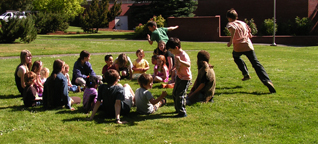Level 2
Level 2: Grades 3 and 4 The Puffins & Plovers
Students in Level 2 are beginning to take on a broader view of the world and of their place in time. Thematic studies focus on storytelling & adventure, delving into history, geography and literature, with explorations of the Lewis & Clark Expedition, Native American Indians and the Oregon Trail. Level 2 students also explore scientific concepts such as states of matter through hands-on exploration and experimentation.
Reading
|
Level 2 classrooms take a workshop approach to reading, with students participating in a variety of reading activities, including whole-class book studies, literature circles, teacher read-aloud reading materials related to thematic studies. Students spend 75 minutes engaged in reading activities three days/week and an hour or more two days/week. The workshop model allows for flexibility based on student interests, skills and needs, and nurtures a culture and love of reading. Reading is one component of literacy instruction, which includes listening, speaking, writing and critical interaction with literature. We emphasize reading for comprehension with a focus on strategies and skills to build fluency, accuracy and vocabulary in a variety of genres. We value students' participation in their reading development, helping them develop skills to select the right materials to help them grow as readers. We have a wide variety of books in the classrooms, including Fountas & Pinnel's guided reading levels and leveled literature collections as well as fiction and non-fiction titles from beginning readers to advanced chapter books. Reading at Level 2 also includes teacher read-alouds from both fiction and non-fiction chapter and picture books.
|
Writing
|
Level 2 students focus on four traits of writing: ideas, organization, sentence fluency and conventions (punctuation and grammar). Some student writing is connected with thematic studies and may involve independent research and report writing while other writing assignments are independent. In our writers' workshop model, teachers provide a mini-lesson focused on a specific skill (e.g., writing introductions or using dialogue to describe a character), then students apply that skill through thematic writing, personal narrative, creative writing (e.g., poetry, realistic fiction) or non-fiction writing (e.g., persuasive essay). Students write most days in reader's response journals. Students frequently write letters to their teachers reflecting on their reading and are offered authentic opportunities to write, such as writing thank you letters to classroom visitors. Students practice keyboarding and sometimes public class or individual books using StoryBird or other means.
|
Mathematics
|
Level 2 students study math in grade-level classes one hour daily. Teachers develop curriculum that uses math situations to foster a deep conceptual understanding of essential mathematical ideas, strategies and models. Classes typically include a mini-lesson with opportunities for practice and collaborative work with partners. Lessons incorporate explicit instruction in strategies as well as flexible thinking and developing arithmetic strategies for solving problems. Students are actively engaged in math through the use of manipulatives and hands-on activities.
|
Social Studies & Science
Science and social studies are integrated through class-wide projects; some science concepts are studied independently through experiments and other hands-on activities. Areas of study are drawn from state and national standards for social studies and science education including the study of heritage, culture, states of matter and others. Social studies and science units provide rich opportunities for Out & Abouts, including visits to such places as the Oregon Historical Society, Portland Art Museum, Oregon Children's Theatre and classroom-based project activities.
Art
Level 2 students have art twice a week for a total of two hours. Building on the foundation laid in the prior level, Level 2 students continue to explore their visual voice as they focus on the basics of design. Their greater maturity allows these students to explore with a broader variety of media. Integration with courses provides depth to in-class projects. Art activities are also incorporated into the main classroom through thematic projects.
Physical Activity
|
We take a comprehensive view of physical activity (PA) at the school, planning our schedules and program with an eye to promoting the habits of physical activity in students. Physical education, breaks, and Out and Abouts are components of our PA program.
Physical Education Students in Level 2 have PE twice a week for 60 minutes. Our program is designed to provide movement experiences through which students continue to develop motor skills as well the characteristics of teamwork and sportsmanship. Through cooperative and competitive games, students learn how to use their bodies for a specific purpose. Recess and Out & Abouts Level 2 students are physical throughout the day and week. With 40 minutes of daily recess time on the playground and weekly Out & Abouts - which typically involve significant walking - we model and promote activity in students. |




